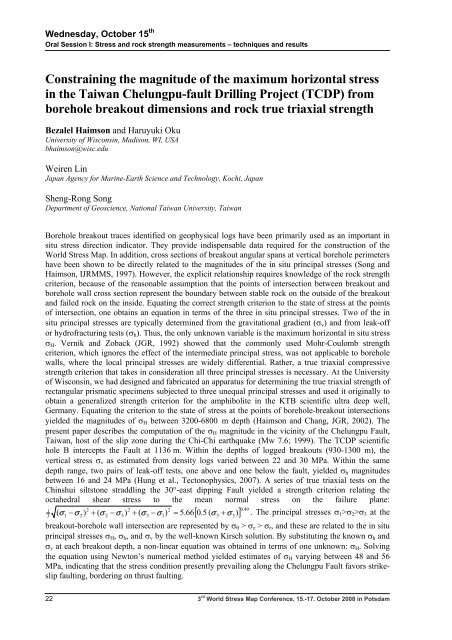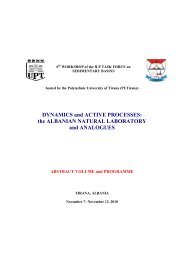World Stress Map Conference - International Lithosphere Program ...
World Stress Map Conference - International Lithosphere Program ...
World Stress Map Conference - International Lithosphere Program ...
You also want an ePaper? Increase the reach of your titles
YUMPU automatically turns print PDFs into web optimized ePapers that Google loves.
Wednesday, October 15 th<br />
Oral Session I: <strong>Stress</strong> and rock strength measurements – techniques and results<br />
Constraining the magnitude of the maximum horizontal stress<br />
in the Taiwan Chelungpu-fault Drilling Project (TCDP) from<br />
borehole breakout dimensions and rock true triaxial strength<br />
Bezalel Haimson and Haruyuki Oku<br />
University of Wisconsin, Madison, WI, USA<br />
bhaimson@wisc.edu<br />
Weiren Lin<br />
Japan Agency for Marine-Earth Science and Technology, Kochi, Japan<br />
Sheng-Rong Song<br />
Department of Geoscience, National Taiwan University, Taiwan<br />
Borehole breakout traces identified on geophysical logs have been primarily used as an important in<br />
situ stress direction indicator. They provide indispensable data required for the construction of the<br />
<strong>World</strong> <strong>Stress</strong> <strong>Map</strong>. In addition, cross sections of breakout angular spans at vertical borehole perimeters<br />
have been shown to be directly related to the magnitudes of the in situ principal stresses (Song and<br />
Haimson, IJRMMS, 1997). However, the explicit relationship requires knowledge of the rock strength<br />
criterion, because of the reasonable assumption that the points of intersection between breakout and<br />
borehole wall cross section represent the boundary between stable rock on the outside of the breakout<br />
and failed rock on the inside. Equating the correct strength criterion to the state of stress at the points<br />
of intersection, one obtains an equation in terms of the three in situ principal stresses. Two of the in<br />
situ principal stresses are typically determined from the gravitational gradient (σv) and from leak-off<br />
or hydrofracturing tests (σh). Thus, the only unknown variable is the maximum horizontal in situ stress<br />
σH. Vernik and Zoback (JGR, 1992) showed that the commonly used Mohr-Coulomb strength<br />
criterion, which ignores the effect of the intermediate principal stress, was not applicable to borehole<br />
walls, where the local principal stresses are widely differential. Rather, a true triaxial compressive<br />
strength criterion that takes in consideration all three principal stresses is necessary. At the University<br />
of Wisconsin, we had designed and fabricated an apparatus for determining the true triaxial strength of<br />
rectangular prismatic specimens subjected to three unequal principal stresses and used it originally to<br />
obtain a generalized strength criterion for the amphibolite in the KTB scientific ultra deep well,<br />
Germany. Equating the criterion to the state of stress at the points of borehole-breakout intersections<br />
yielded the magnitudes of σH between 3200-6800 m depth (Haimson and Chang, JGR, 2002). The<br />
present paper describes the computation of the σH magnitude in the vicinity of the Chelungpu Fault,<br />
Taiwan, host of the slip zone during the Chi-Chi earthquake (Mw 7.6; 1999). The TCDP scientific<br />
hole B intercepts the Fault at 1136 m. Within the depths of logged breakouts (930-1300 m), the<br />
vertical stress σv as estimated from density logs varied between 22 and 30 MPa. Within the same<br />
depth range, two pairs of leak-off tests, one above and one below the fault, yielded σh magnitudes<br />
between 16 and 24 MPa (Hung et al., Tectonophysics, 2007). A series of true triaxial tests on the<br />
Chinshui siltstone straddling the 30°-east dipping Fault yielded a strength criterion relating the<br />
octahedral shear stress to the mean normal stress on the failure plane:<br />
[ ] 49 . 0<br />
0.<br />
5 ( σ<br />
1 2<br />
2<br />
2<br />
3 ( σ 1 − σ 2)<br />
+ ( σ 2 −σ<br />
3)<br />
+ ( σ 3 −σ<br />
1)<br />
= 5.<br />
66 3 + σ 3)<br />
. The principal stresses σ1>σ2>σ3 at the<br />
breakout-borehole wall intersection are represented by σθ > σz > σr, and these are related to the in situ<br />
principal stresses σH, σh, and σv by the well-known Kirsch solution. By substituting the known σh and<br />
σv at each breakout depth, a non-linear equation was obtained in terms of one unknown: σH. Solving<br />
the equation using Newton’s numerical method yielded estimates of σH varying between 48 and 56<br />
MPa, indicating that the stress condition presently prevailing along the Chelungpu Fault favors strikeslip<br />
faulting, bordering on thrust faulting.<br />
22 3 rd <strong>World</strong> <strong>Stress</strong> <strong>Map</strong> <strong>Conference</strong>, 15.-17. October 2008 in Potsdam




